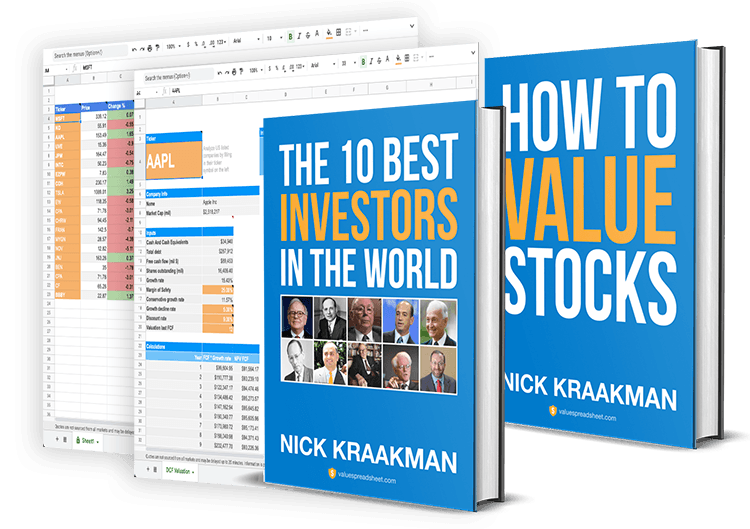Transcript
Hello, hello, welcome back to the Value Investing Bootcamp podcast!
I am your host, Nick Kraakman, and in this particular episodes I will share with you my #1 way to find attractive investment opportunities, and it uses the power that the internet has given us.
The internet has provided us with many sources of financial information, and it creates some sort of an information overload from time to time.
What we actually need is a way to filter through all the garbage, to filter out all the garbage and actually find those hidden gems inside this jungle of stocks and information.
So, how can we do this?
Well, the internet is full of useful tools, and these filtering tools are called screeners, stock screeners.
What they allow you to do is to set some criteria, so you have to know what you're looking for, I'll tell you in a minute, and what it does, it sort of searches through the entire spectrum of available stocks and only shows you the ones that fit the criteria that you set.
If we look at what value investors are looking for, they're looking for companies that are highly profitable, that have a healthy financial position, so not too much debt, and they are able to pay their obligations and earn above average returns on equity.
So, if we input these things in a stock screener... let me first share with you some of my favorite stock screeners.
I usually go to Yahoo Finance. So, that is finance.yahoo.com, and they have a free stock screener, which works great.
You have a lot of options, you can add a lot of screening criteria there.
Another option is the Motley Fool.
It's a strange name, and it's actually a very interesting website.
I learned a lot from this when I was just starting out.
They have a lot of articles written about value investing.
However, I must say they are a bit heavy on the sales, but if you're able to look past that, they have some very interesting information regarding value investing, so check it out.
The website is www.fool.com, and that is F-O-O-L.
They have a community, it's called the CAPS community.
They also have a stock screener there, and this is a pretty cool screener, because it's different from all the other ones.
You can actually search on the rating that analysts give the company, but also that the community, the Motley Fool Community, give the particular stock.
This just gives you a different angle to look for stocks.
So, stocks with a high rating for example, that means that the majority of the community believes that this is a high quality company.
You shouldn't trust this blindly, but like I said, it's just another angle you can look at.
Another very valuable and often used screener too is Finviz, F-I-N-V-I-Z. They have a pretty cool stock screener as well, you can use that.
So, what are the criteria that you can use?
Well, we discussed earlier in earlier episodes that return on equity is an important metric for value investors, because it indicates, if it's high, that it's a highly profitable company, that it's able to generate a lot of money on every dollar they invest into the company, and yeah, that's what we're looking for.
So, for example, you can input return on equity higher than 15%.
Also, we discussed the debt to equity ratio, which indicates how much debt the company has.
The less debt the better, because debt means interest payments, and this can get out of hand quite quickly if a company has some sort of a setback.
We always prefer companies with a low debt to equity ratio, so you can set the debt to equity criteria to lower than 0.5.
Another thing you can input, for example, is the current ratio.
We haven't covered that one yet, but it's a measure which indicates if a company is able to pay its short term obligations.
So, if this is too low, then it means that a company might not be generating enough cash to actually pay its short term obligations and it might get into trouble quite quickly.
I believe Benjamin Graham, but it could be someone else, some other big investors, who always looks for a current ratio of two or higher.
So, you can set this as a criteria as well.
The result is that you are shown a list of companies that meet all these criteria.
These are possibly interesting companies.
It's probably still quite a big list, and the thing is, you could add more criteria, or you can make your criteria a bit stricter, to filter down this list even further, but at some point you will have to say, okay, this is my list, my initial list of ideas.
I will take them and look into them further, into further detail, and this will probably require some manual labor, because yeah, I'm sorry, you can't automate everything.
For example, we talked about shareholder friendly management.
This is something you can check for each of these companies, and then just drop the ones from the list that don't fit their requirements.
Same with a sustainable competitive advantage.
Try to dismiss the companies in your list that do not have a sustainable competitive advantage.
And also, it's called in the value investing terminology your "circle of competence".
Try to filter out the companies which are in industries that you know nothing about.
If the company is too complex for you, if you don't really understand what they are doing, how they are making their money, drop them from the list as well, because that makes it so much harder to analyze and make your predictions and your analysis just less valid.
What you are left with is probably just a couple of companies, at least that's the idea, which fit all the criteria that you set.
This is a great little list that you have left, and the last step is actually just to determine the value of the companies on this list to see whether they are actually cheap as well, because now with all these criteria, we assess whether this is a good company, and now it is time to see whether it's a cheap company, and if so, then it might be an interesting moment to buy, and if not, put them on your watch list.
I mean, you can use them for later, you can look at them later when their price drops, and so yeah, this was my number one way to-- This is actually a bit of my investment process that I go through.
Another way to generate ideas other than stock screeners is of course to subscribe to newsletters or to read blogs.
Or also, there's this website, gurufocus.com, where you can see what the gurus, what the big guys, the hot shots in the industry, are buying, and then get your ideas from there and start your analysis there, but I always prefer to use the stock screeners, it's my number one way.
So, thank you very much for listening.
In the next episode we will cover how to actually calculate the value of a company, which is a crucial step in your investment process.
So, I hope to see you there, and again, spread the love and let other people know about this podcast.
I wish you an amazing day, and we'll talk to each other soon.
If you enjoyed today's show, head over to ValueInvestingBootcamp.com to find out more on how you can invest like the pros, manage your own portfolio with confidence, and consistently earn mind boggling returns on the stock market.



